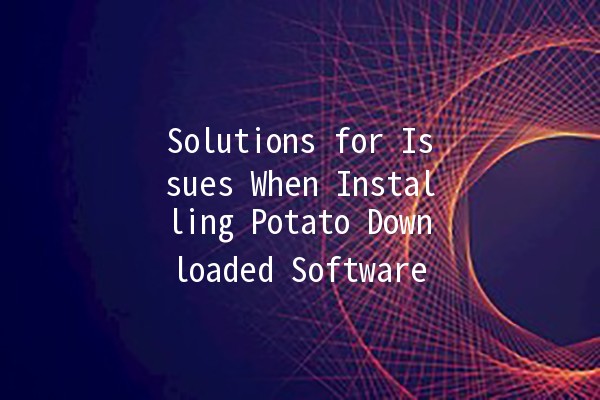In today's digital landscape, downloading software applications has become a routine task. However, it is not uncommon for users to encounter installation issues, especially when dealing with specific software like "Potato." This article delves into common installation setbacks and provides effective solutions to ensure a seamless experience after downloading.
Understanding Potato Software
Potato software is popular among users for its versatility and ease of use. However, installation problems can arise due to multiple factors, including system compatibility, corrupted files, or incorrect configurations. Understanding these aspects is crucial for troubleshooting.

Common Installation Issues
One of the primary reasons for installation failures is incompatibility with the user's operating system. Here's how to tackle this issue:
Check System Requirements: Before downloading, always verify that your computer meets the software requirements specified by Potato. This typically includes CPU, RAM, and storage space.
Solution in Action: If the software requires Windows 10 but you're using Windows 7, consider upgrading your operating system or finding a compatible version of the software.
Sometimes, the files downloaded can become corrupted due to interruptions in the downloading process. Here’s how to resolve this:
ReDownload the Software: It's essential to ensure that the downloaded file is complete and uncorrupted. Delete the current file and download again from the official Potato website or a trusted source.
Verify File Integrity: If available, use checksums provided on the download page to ensure the file hasn’t been tampered with.
Another common hurdle comes from insufficient permissions to install new software. Here’s a way to solve this:
Run as Administrator: Rightclick the installation file and select “Run as Administrator.” This often provides the necessary permissions to install.
Adjust Security Settings: If you continue experiencing issues, you may need to tweak your system security settings or add the installer to the list of trusted applications.
Sometimes, antivirus programs misinterpret software installations as threats, leading to installation blocks. Here’s how to address this:
Temporarily Disable AntiVirus: Before installation, turn off your antivirus program. Remember to reenable it after installation.
Whitelist the Software: For ongoing installations, consider adding Potato to your antivirus whitelist. This prevents your security software from blocking the installation.
Insufficient disk space can also hinder installations. Here’s the fix:
Free Up Space: Check your disk space before installing. Delete unnecessary files or uninstall unused applications to create sufficient room.
Use Disk Cleanup Tools: Utilize builtin disk cleanup tools or thirdparty software to manage your storage effectively.
ProductivityBoosting Tips for Software Installation
By improving your software installation process, you can enhance your overall productivity. Here are five tips to consider:
Ensure that your existing software and operating system are uptodate. Updates often resolve compatibility issues and improve security. For instance, running an outdated OS may affect your ability to install newer versions of applications, including Potato.
Before any major software installations, creating a system restore point is a wise precaution. It allows you to revert to your prior system state if something goes wrong during installation.
Implementation: On Windows, search for "Create a restore point" in the Start menu, select your drive, and click "Create."
If you're unsure whether new software will integrate well with your system, consider creating a virtual machine. This allows you to run a separate OS environment where you can install and test new software without risking your primary system's stability.
Backing up important files and data ensures that you don’t lose significant information in case of installation failures or system errors. Regular backups are a crucial aspect of effective data management.
Maintaining clear documentation of your installation process aids in troubleshooting future issues. By noting any problems and their resolutions, you create a personal knowledge base that can be referred to for future installations.
Frequently Asked Questions
Q1: Why won’t my Potato software start after installation?
Sometimes, the software may fail to launch due to background applications or incorrect system settings. Ensure that no other similar applications are running, and check your system settings to verify if everything is configured correctly.
Q2: What should I do if my Potato installer is stuck?
If your installer freezes, close the installation window and restart your computer. Try running the installer again with administrative privileges. If the issue persists, check for any system updates that may be required.
Q3: Can I install Potato software on multiple devices?
Yes, you can typically install Potato software on multiple devices as long as you comply with the licensing agreement. Check Potato’s policy regarding installations on more than one device to avoid any potential issues.
Q4: My antivirus flagged the Potato software as a threat. Should I proceed?
If your antivirus program flags the software, it’s essential to verify its legitimacy. Visit the official Potato website for clarity on whether the download was genuine. If confirmed, temporarily disabling the antivirus during installation should suffice.
Q5: What if my Potato software installation is complete, but it’s missing features?
Missing features can result from partial installs or compatibility issues. Uninstall the software, ensure your system meets all requirements, and then reinstall it to rectify these problems.
Q6: How can I get customer support for Potato issues?
For direct support, visit the Potato website and check for their customer service options, including support tickets or live chat. They often have dedicated support for installation issues.
By following these solutions and productivity tips, you'll enhance your software installation experience and minimize potential headaches. The key lies in understanding the common pitfalls and being proactive in your approach to maintaining your system.